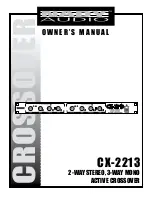
© 2003 TDM Audio, Inc.
Electronic Crossover Owner’s Manual
Page 11
Hooking Up the Crossover
nce your TDM crossover is installed in the rack, you are ready to hook it up to your
equipment. Of course, the method used to hook up any crossover depends on how it will be
used. We will try to give you the basics in this manual, but you may need to tailor the
methods described here to your particular application.
What You’ll Need
To connect your 24CX series crossover to your equipment, you will need the following.
•
Power:
A power outlet should be located close enough to the unit so that you can plug it
in. The 24CX series crossovers require a grounded (3-prong) outlet. If an outlet is not
close enough, an extension cord or power strip may be used. Check the power rating on
the extension cord or power strip to make sure that it exceeds the power requirements of
all units plugged into it combined. TDM units have their power requirements marked on
the rear of the unit.
•
Signal Cables:
You need one cable to connect your signal source to the input of each
crossover channel that you will be using, and one cable to connect each crossover band
output from the channel to your amplifier input. TDM 24CX series crossovers have many
possible configurations. For example, if you are connecting a 24CX-2 for stereo 2-way
use, you need two cables to feed your stereo signal source into the two channel inputs,
and two cables for each channel (for a total of four) to feed the low and high outputs to
your amplifiers.
Making Adapter Cables
In order to hook up your crossover to the rest of your equipment, it may be necessary to use
special adapter cables. 24CX series crossovers can be shipped from the factory with either ¼”
phone jacks, or with XLR connectors. In either case, inputs and outputs are balanced. The ¼”
phone jacks are tip-ring-sleeve type for balancing. It is common to need adapters to go from ¼”
to XLR or vice versa. It is very important that if you build your own adapters, you adhere to
certain rules to make sure your TDM unit functions correctly.
If you have a TDM crossover with XLR connectors and you need to connect it to some other
piece of equipment that has ¼” connectors, you might need to build XLR to ¼” adapters. If the
other piece of equipment is balanced with tip-ring-sleeve jacks, then do the following.
•
Wire pin 1 of the XLR connector to the sleeve of the tip-ring-sleeve plug.
•
Wire pin 2 of the XLR connector to the tip of the tip-ring-sleeve plug.
•
Wire pin 3 of the XLR connector to the ring of the tip-ring-sleeve plug.
If the other piece of equipment is not balanced, but has plain ¼” connectors, then do the
following.
•
Wire pins 1 and 3 both to the sleeve of the ¼” phone plug.
•
Wire pin 2 to the tip of the phone plug.
O



























